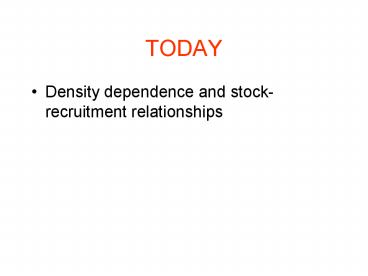TODAY - PowerPoint PPT Presentation
1 / 35
Title:
TODAY
Description:
For true population regulation, rates of birth and death must ... cannibalism. Density-dependence: evidence? Mortality in fish populations: Density-dependence: ... – PowerPoint PPT presentation
Number of Views:63
Avg rating:3.0/5.0
Title: TODAY
1
TODAY
- Density dependence and stock-recruitment
relationships
2
Evidence for density dependent mortality in
recruitment of a temperate reef fish, cunner
(Tautogolabrus adspersus), among similar reefs in
the vicinity of an anthropogenic
disturbancePaul Nitschke1, Martha Mather,
Massachusetts Cooperative Fish and Wildlife
Research UnitandFrancis Juanes, Department of
Natural Resources ConservationUniversity of
Massachusetts, Amherst, MA 01003
3
Density-dependence and regulation
- Populations cant increase without bounds
- For true population regulation, rates of birth
and death must depend on density - Population responses can be non-linear
- Growth and/or survival can be den-dep
4
Density-dependence
- Populations cant produce less progeny than
needed to replace themselves - Populations tend to produce more progeny than
needed to replace themselves
5
Density-dependence
- Mortality in fish populations
- Functional form is Nt N0e-Zt
- Because Survival Nt / N0 Z - ln S
6
(No Transcript)
7
Density dependent mortality
DD loss
8
Density-dependence implications for fisheries
- If density-dependence is important
- Fishing mortality is compensatory
- If density-independence is more important
- Fishing mortality can be additive
9
Density-dependence how do we detect it?
- Plot mortality (or fecundity, growth) vs. density
(regression) - often life stage specific
- obscured by variation and insufficient range of
densities
10
Density-dependence mechanisms?
- delayed or advanced maturation
- increased or decreased fecundity
- faster or slower growth
- increased or decreased predation
- cannibalism
11
Density-dependenceevidence?
- Mortality in fish populations
12
Density-dependence evidence?
- Growth in fish populations
13
Stock-recruitment relationships
- Number of offspring vs number of parents
14
Stock-recruitment relationships
- Stock
- part of population under consideration for actual
or potential utilization or - sample of individuals with similar production
characteristics - Recruitment
- of individuals still alive at some specified
point in time (stage) after the egg stage
15
Stock-recruitment relationships
Population is a function of population size at a
previous time Avoids problem of non-linear birth
rates First developed for species with
non-overlapping generations
16
Stock-recruitment relationships
In more familiar terms
In general
17
Stock-recruitment relationships
- What is ??
- a ratio between generations, or
- net reproductive rate or ,
- net per capita rate of increase
- Nk1 recruits (offspring)
- Nk stock (adults)
18
Stock-recruitment relationships
- Plot Nk1 vs Nk
- Simple density-independence
- if ? 1, population is constant
- if ? lt 1, population is decreasing
- if ? gt 1, population is increasing
19
? gt 1
Nk1
? 1
? lt 1
Nk
20
Stock-recruitment relationships
- Principles
- curve must pass through origin
- no other S level results in 0 recruits
- R must exceed S over some part of the range of S
21
Interpreting the shape ofstock-recruitment
relationships
- Straight S-R curve implies density-independence
- Non-linear curve implies density-dependence
- Decreasing slope compensatory
- Increasing slope depensatory
22
Compensatory SR
deaths
births
Nk1 Nk
Nk1
Nk
23
What about Nk vs time?
K
Nk
time
24
Interpreting the shape ofstock-recruitment
relationships
- Compensatory curves
- rate of recruitment decreases continually (i.e.
slope maximum _at_ origin) - When curve meets replacement line K
- Angle of intersection determines dynamics
- Maximum recruitment max distance
25
Interpreting the shape ofstock-recruitment
relationships
- SR curves have
- Density-dependent feedbacks, and
- Built-in time lags,
- Therefore complex dynamics
- Increasing angle of intersection like increasing
TAU (time lag)
26
lt90º stable point damped oscillations
90º stable cycle
gt90º divergent oscillations
27
What about depensation?
births
deaths
Deaths Type II FR
Nk1 Nk
Nk1
Nk
28
What about Nk vs time?
Kupper
Klower
29
Stock-recruitment relationshipsdepensation
- Mechanisms
- Constant predation
- Allee effect
30
Stock-recruitment relationshipsassumptions
- Linear and curvilinear relationships possible
- Average S-R curve does not change
- All individuals are alike
- S and R measured without error
- Unit stock exists
31
Stock-recruitment relationshipssummary
- Can incorporate density independence
- With simple density-dependence produce one
equilibrium - Angle of intersection of SR and replacement line
determine oscillations - Incorporating a type II FR produces a low-density
unstable equilibrium - Type III FR?
32
Stock-recruitment relationships2 main types
- Beverton-Holt
33
Stock-recruitment relationships2 main types
- Beverton-Holt
- Recruitment assymptotic
- Intra-year feedback
- Recruits limited by food/habitat
- Marine species
34
Stock-recruitment relationships2 main types
- Ricker
35
Stock-recruitment relationships2 main types
- Ricker
- Recruitment declines at high stock sizes
- (greater den-dep)
- Inter-year feedback
- Recruits limited more by predation
- Anadromous species































